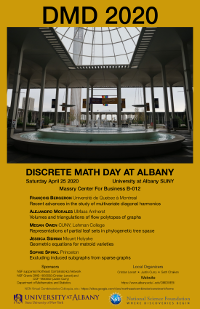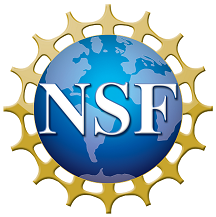
Discrete Mathematics 2-Day at Albany
Virtually Sat/Sun April 25-26, 2020
Northeast Combinatorics Network


|
Discrete Mathematics 2-Day at AlbanyVirtually Sat/Sun April 25-26, 2020Northeast Combinatorics Network |

|
| Sat. 2:30 | Darren Narayan (Rochester Institute of Technology)
Two Approaches For Breaking Graph Symmetry
Abstract: We consider two approaches for removing symmetry from graphs. Albertson and Collins defined the distinguishing number of a graph \(D(G)\) to be the minimum \(r\) such that there is a labeling of the vertices with \(r\) colors such that no non-trivial automorphism preserves all of the vertex labels. Brewer et al. defined the \emph{asymmetric index of a graph} \(ai(G)\) to be the minimum \(r+s\) needed to change \(G\) into an asymmetric graph (a graph whose only automorphism group on its vertices is the trivial automorphism). Both of these methods are aimed at removing graph symmetry as efficiently as possible, and in fact for some families of graphs, \(D(G)-ai(G)\leq 1\). However we show that there exist graphs where either \(D(G)-ai(G)\) or \(ai(G)-D(G)\) can be made arbitrarily large. |
| Sat. 2:50 | Moshe Cohen (State University of New York at New Paltz)
The genus of a random 2-bridge knot
Abstract: A knot is a 4-valent planely-embedded graph whose vertices are decorated with under- and over-crossing information. We choose a specific graph and assign crossing information at each vertex, obtaining a binary string representing the ordered crossings of the knot. We restrict to the easier class of 2-bridge knots, obtaining a concise list of associated binary strings, and use these to obtain alternating diagrams. From these alternating diagrams we count the number of circles yielded by Seifert's algorithm. Finally, we count the contribution to the expected genus not by each knot individually but by local contributions from the crossings. |
| Sat. 3:10 | Keith F. Grover (State University of New York at New Paltz
The determinant of a random 2-bridge knot
Abstract: A knot is a 4-valent planely-embedded graph whose vertices are decorated with under/overcrossing information. We choose a specific graph and assign crossing information at each vertex. We encode this crossing information as a binary string and use this string to generate an Alexander matrix whose determinant is the determinant of the original knot: a positive integer value. We tabulate the determinants of all 2-bridge knots with crossing numbers up to 22 using computer calculation. This talk is based on joint work with Moshe Cohen. |
| Sat. 3:30 | Qays Shakir (Middle Technical University, Bagdhad)
Tight Surface Graphs
Abstract: In this project, we study inductive constructions for tight graphs that are embedded in surfaces without edge crossings. In particular, for \((2,2)\)-tight graphs on a torus, we exhibit a complete inductive construction for such graphs. We give the complete list of all small \((2,2)\)-tight torus graphs from which the class of \((2,2)\)-tight torus graphs can be built. We also give a geometric application of this result to representations of \((2,2)\)-tight torus graphs as contact graphs of configurations of circular arcs. |
| Sun. 1:00 | Lauren Rose (Bard College)
SETS and QUADS
Abstract: Quads is a variation of the popular card game Set, but in this case we have 4 states for each attribute and allow additional groupings of 4 cards to make a Quad. We start with the mathematics of Set (in \(n\) dimensions) and derive a robust system for Quads that also generalizes to \(n\) dimensions. |
| Sun. 1:20 | Logan Crew (University of Pennsylvania)
A Deletion-Contraction Relation for the Chromatic Symmetric Function
Abstract: Richard Stanley introduced the chromatic symmetric function of a graph \(G = (V,E)\)$ as a generalization of the chromatic polynomial \(\chi_G(x)\), defined by \[ X_G(x_1,x_2,\dots) = \sum_{\substack{\kappa: \, V(G) \, \rightarrow \, \mathbb{Z}^+ \\ uv \, \in \, E(G) \implies \kappa(u) \, \neq \, \kappa(v)}} \prod_{v \in V(G)} x_{\kappa(v)} \] In this talk, we extend the definition of \(X_G\) to include graphs \((G,w)\) with a vertex-weight function \(w: V(G) \rightarrow \mathbb{Z}^+\). This allows us to generalize the deletion-contraction relation of the chromatic polynomial. I will show how we can use this relation to prove new properties and extend classical properties of \(X_G\) by proving them for the class of all vertex-weighted graphs. These proof methods are similar to those used for analogous properties of the chromatic polynomial, and give a new perspective for considering the chromatic symmetric function. This is joint work with Sophie Spirkl. |
| Sun. 1:40 | Laura Colmenarejo (UMass Amherst)
An insertion algorithm for diagram algebras}
Abstract:We generalize the Robinson-Schensted-Knuth algorithm to the insertion of two-row arrays of multisets. This generalization leads to an algorithm from partition diagrams to pairs of a standard tableau and a standard multiset tableau of the same shape, which has the remarkable property that it is well-behaved with respect to restricting a representation to a subalgebra. This insertion algorithm matches recent representation-theoretic results of Halverson and Jacobson. This is joint work with R. Orellana, F. Saliola, A. Schilling, M. Zabrocki. |
| Sun. 2:00 | James Sidoli (University at Albany, SUNY)
Compression of Spherical Whittaker Functions in Type A
Abstract: We exhibit a Haglund, Haiman, Loehr (HHL) type formula for the spherical Whittaker function, i.e. as a sum over fillings of a Young diagram. This new formula is purely combinatorial and is derived via compression from an alcove walk formula. We then compress our HHL-type formula to a semistandard Young tableaux (SSYT) formula known as Tokuyama's formula using a binary generation tree. |
| Sun. 2:20 | Adam Schultze (University at Albany, SUNY
Combinatorial models for representations of affine Lie algebras
Abstract: Crystals are colored directed graphs encoding information about Lie algebra representations. Kirillov-Reshetikhin (KR) crystals correspond to important finite-dimensional representations of affine Lie algebras. There are two main combinatorial models for tensor products of (column shape) KR crystals: the tableau model (type specific, applying to the classical types) and the quantum alcove model (uniform for all untwisted affine types). The former is based on certain fillings of columns with positive and negative integers, known as Kashiwara-Nakashima columns. The latter, due to Lenart, Naito, Sagaki, Schilling, and Shimozono, is based on paths in the so-called quantum Bruhat graph on the corresponding finite Weyl group. While the tableau model is simpler, it has less easily accessible information, so it is generally hard to use in specific computations: of the energy function (defining a grading on KR crystals), the combinatorial R-matrix (the unique affine crystal isomorphism commuting tensor factors) etc. As these computations are much simpler in the quantum alcove model, an alternative is to relate them to the tableau model, via an affine crystal isomorphism between the two models. This has been achieved in types A and C by Lenart and Lubovsky. We extend this work to types B and D, where the corresponding bijection has important additional features. The talk will be largely self-contained. On Combinatorial Models for Affine Crystals https://arxiv.org/abs/1911.10957 |
Discrete Math Days in the Northeast is a series of one-day research meetings that seeks to bring together a community of combinatorists in the northeast. We seek to provide a relaxed atmosphere, a friendly environment conducive to fostering collaboration across institutions and disciplines.
We hold three meetings per year, Fall, Spring and Summer Combo. The meetings take place at different colleges and universities in the northeast. Most participants drive to and from the conference on the same day. We hope that by holding meetings at different universities it will make it possible for researchers with higher teaching loads and those with limited institutional support to attend, and helped them to keep up with research in their field.
We also seek to provide a non-intimidating entry into the mathematics community for graduate students and very strong undergraduates in the region.
We now also hold several Virtual Combinatorics Colloquia throughout the academic year.
Discrete Math Days in the Northeast is organized by the Northeast Combinatorics Network and funded by the US National Science Foundation.

National Science Foundation
Discrete Math Day at Albany 2020 is also supported by Univ. at Albany NSF grants DMS-1855592 (PI: Cristian Lenart) and CCF-1850052 (PI: Justin Curry), and by the University at Albany Department of Mathematics and Statistics.